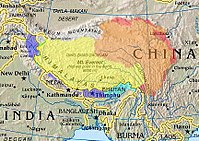
Photo from wikipedia
Abstract Ecosystems are experiencing unprecedented climate change during the past decades, which drove evident shifts in ecosystem states, processes and functions. Understanding ecosystem stability is critical for accurately assessing and… Click to show full abstract
Abstract Ecosystems are experiencing unprecedented climate change during the past decades, which drove evident shifts in ecosystem states, processes and functions. Understanding ecosystem stability is critical for accurately assessing and predicting ecosystem state shifts when exposed to climate fluctuations. Here, we disentangled and evaluated the dimensionality of ecosystem stability in terms of productivity substituted by normalized differential vegetation index (NDVI) in response to climate changes in temperature, precipitation, and solar radiation, temporally or spatially. Invariability, resistance, and resilience were considered as the stability components for five different grassland types across the Tibetan Plateau. The dimensionality of ecosystem stability was derived from the pairwise correlation matrics between invariability, resistance, and resilience. Our results confirmed that ecosystem productivity stability is grassland-type specific, with alpine meadows and steppes being more stable than temperate meadows, steppes, and desert-steppes. The dimensionality and components of grassland stability on the Tibetan Plateau showed strong altitudinal dependence. Invariability and resistance first increased and then decreased along increasing altitudes, with their maximums peaking at the middle-altitudes of ~3,750 m. However, the resilience of ecosystem productivity linearly increased with increasing altitudes. Correlations among stability components were highest at the altitude of ~ 3,300 m, where is the transition zone between temperate and alpine grasslands and the lowest dimensionality of ecosystem stability. Finally, we suggest that the altitudinal shifts of stability dimensionality might be the signals of grassland state transition from temperate to alpine grasslands on the Tibetan Plateau.
Journal Title: Agricultural and Forest Meteorology
Year Published: 2020
Link to full text (if available)
Share on Social Media: Sign Up to like & get
recommendations!